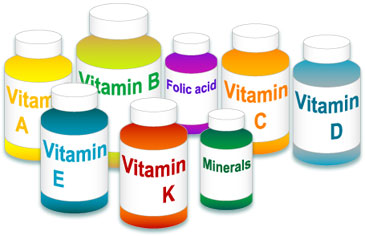VITAMIN TIME: HEALTH SERIES – Part 3
OK. So we’ve covered quite a bit and I’m blindly supposing that you are beginning to get the feel of the importance of consuming vitamins. Well, if you still have any questions feel free to question me via email or just make things easier on yourself and continue listening. The last three vitamins I’m going to touch on in this segment are Vitamin’s D and E. But there’s also a bonus: I’m going to throw in a little bit about minerals as well; their purpose and minimum daily requirements.
1. Vitamin D
Vitamin D strengthens the bones through the absorption of bone building calcium. Vitamin D is produced by the body in the presence of sunlight. But you don’t have to be a sunbather to get it. You can also get vitamin D from egg yolks, fish oils, and fortified foods like milk. Of course, I don’t have to school you on the importance of vitamin D, especially when we get older and our bones have the tendency to become more and more brittle over time. In fact, most research suggest that women (who lose more none faster than men) need to start supplementing vitamin D and other bone building substances into their early 30’ and low 40’s to prevent osteoporosis. Teenagers need 5 micrograms of vitamin D from food every day.
Optimal Intake: Vitamin D should be taken in 5 micrograms up to the age of 50, 10 micrograms between the ages of 51 and 70, and 15 micrograms after 70. Very few foods naturally contain vitamin D. But, good sources of vitamin D include dairy products and breakfast cereals (which are fortified with vitamin D), and fatty fish such as salmon and tuna. Multivitamins seem to do the trick for me, streamlining my supplementation daily for ease of management.
2. Vitamin E
Mr.Antioxidant. This vitamin elps protect cells from damage and such things called free radicals. It is also important for the health of red blood cells. Vitamin E is found in many foods such as vegetable oils, nuts, and leafy green vegetables. Avocados, wheat germ, and whole grains are also good sources of vitamin E. Teenage boys and teenage girls need 15 mg of vitamin E every day.
Optimal Intake: The recommended daily intake of vitamin E from food now stands at 15 milligrams. That is the equivalent of 22 IU from the natural-sources of vitamin E or 33 IU of the synthetic form. Researches into the optimum amount of vitamin E needed by the body are still going on. Evidence from observational studies suggests that at least 400 IU of vitamin E per day, and possibly more, are needed for optimal health. Since standard multivitamins usually contain around 30 IU, a separate vitamin E supplement is needed to achieve this level.
Function of Minerals: Why Do They Do?
Here are just a three purposes of minerals:
1) They provide structure for forming bones and teeth.
2) Assist with maintaining a normal heart rhythm, muscle contractility, neural conductivity, and acid-base balance.
3) Help to regulate cellular metabolism by becoming part of enzymes and hormones that modulate cellular activity.
Minerals Required by the Body
Approximately 4% of the body’s mass consists of minerals. This percentage of minerals are classified as trace minerals. Which means that the body requires less than 100 mg/day. While on the other hand, major minerals require more than 100 mg/day. Good News: minerals can be found in water and soil. And guess that that means for us? Animals and plants will ingest them and we will subsequently ingest them giving us the minerals we need.
1. Trace Minerals
Iron, zinc, copper, selenium, iodine, fluorine and chromium.
2. Major Minerals
Sodium, potassium, calcium, phosphorus, magnesium, sulfur and chlorine.
Bad News: minerals cannot be made in the body and must be obtained from our diet. A well-balanced diet should meet the requirements of minerals.
That’s it for Vitamins. Stay healthy gang!
Categories
Archives
- October 2018
- September 2018
- May 2016
- March 2016
- February 2016
- December 2015
- November 2015
- October 2015
- September 2015
- August 2015
- July 2015
- June 2015
- May 2015
- April 2015
- March 2015
- February 2015
- January 2015
- November 2014
- October 2014
- April 2014
- March 2014
- February 2014
- January 2014
- December 2013
- November 2013
- October 2013
- September 2013
- August 2013
- July 2013
- June 2013
- May 2013
- March 2013
- February 2013
- January 2013
- December 2012
- November 2012
- October 2012
- August 2012
- July 2012
- November 2011

